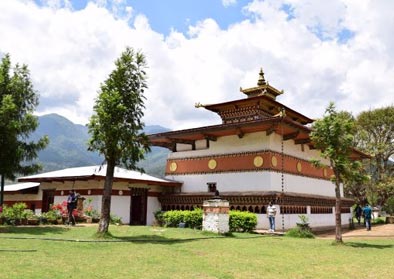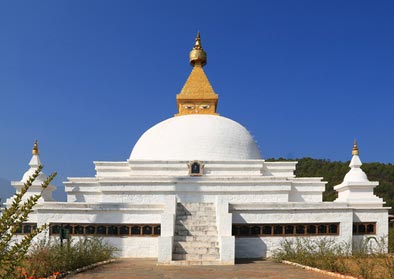Punakha
Punakha was the capital of Bhutan until the 1960’s, and the serene beauty of the Punakha River, the exotic resorts and the unspoiled beauty of the landscape offers the memory of a lifetime. The place with its regal past is still the winter seat of Je Khenpo (the chief abbot). Along with Paro and Jakar, Punakha completes the triangle of most popular tourist destinations. The valley of Punakha boasts a pleasant climate with warm winters and hot summers. Owing to its favourable climatic conditions, rice has become the main cash crop cultivated in the region.


Excursions around Punakha
Chimi Lhakhang - Situated on a hillock in the centre of the valley, Chimi Lhakhang is dedicated to Lama Drukpa Kuenley, who during the late 15th century used humour, songs and outrageous behavior to dramatise his teachings. It takes around 30 minutes to walk across field from the road to the temple. The trail leads across rice fields to the tiny settlement of Pana, meaning "field".
Khamsum Yulley Namgyal Chorten - Built to remove negative forces and promote peace, stability and harmony in the changing world, Khamsum Yulley Namgyal Chorten can be reached by a beautiful hike.
Sangchhen Dorji Lhuendrup Lhakhang Nunnery - Housing a 14 foot main bronze statue of Avalokiteshvara (Chenrigzig chagtong chentong), the temple complex also houses a permanent higher learning and meditation centre for nuns where, apart from religious trainings, it provides life skill training such as tailoring, embroidery, statue making and thangka painting.
Talo - Situated along the hill slopes, the village of Talo is known for its cleanliness and hygiene among Punakha villages. Talo Sangnacholing is built on a plateau and has majestic view of surrounding villages.
Punakha Ritsha Village - The Punakha Ritsha Village is famous for rice farming, and both red and white rice are grown along the river valleys of Pho and Mo Chhu, two of the most prominent rivers in Bhutan. This is a model rice growing village in western Bhutan.
Best time to visit Punakha
March - May is the best time to visit Punakha. Spring time is considered the best time to visit Punakha, and the weather is pleasant and loved by many. In this time the maximum temperature that you would experience is 26 degrees Celsius while the minimum would be somewhat around 5 degree Celsius.
How to reach Punakha
The best way to travel to Punakha is to take a flight to Paro International Airport. From the airport, buses and taxis are available to go to Punakha Valley. From Thimphu to Punakha, the distance is 86 km, while from Paro the distance is 126 km. From the Southern border town of Gelephu to Punakha, the distance is 194 km. From Wangdue to Punakha, the distance is 23 km. From Trongsa to Punakha, the distance is 138 km. The distance between Bumthang and Punakha is 217 km.
